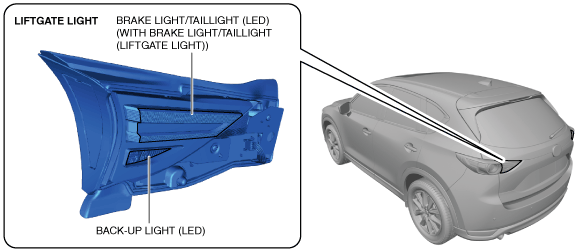 |
ac5wzn00004703
LIFTGATE LIGHT
id091800011900
Purpose
Function
|
Operation part |
Related light |
|---|---|
|
• TCM (selector lever) (ATX)
• Back-up light switch (shift lever) (MTX)
|
Back-up light
|
|
Brake switch (with brake light/taillight (liftgate light))
|
Brake light
|
|
Light switch (TNS (parking lights)) (with brake light/taillight (liftgate light))
|
Taillight
|
Structure/Construction
ac5wzn00004703
|
Operation
Back-up light
ac5uun00002532
|
ac5uun00002533
|
Brake light (with brake light/taillight (liftgate light))
ac5uun00002534
|
ac5uun00002535
|
Taillight (with brake light/taillight (liftgate light))
ac5uun00002536
|
Fail-safe